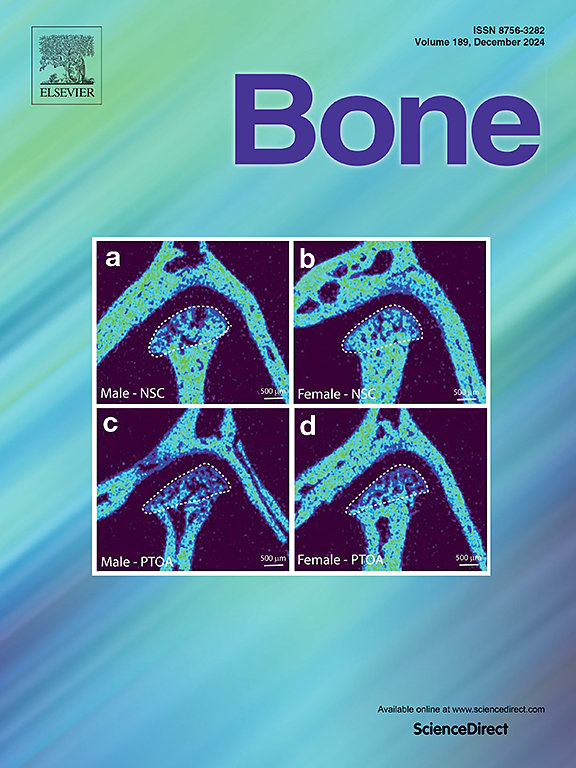A 2D-registration algorithm for the correction of motion-induced misalignments of consecutive image stacks in multi-stack high-resolution peripheral quantitative CT scans
IF 3.6
2区 医学
Q2 ENDOCRINOLOGY & METABOLISM
引用次数: 0
Abstract
Multi-stack imaging using high-resolution peripheral quantitative CT (HR-pQCT) can involve misalignments of consecutive image stacks (‘stack shift’) due to subject movement during scan acquisition. We developed a simple, 2D-registration algorithm for the correction of stack shifts in multi-stack HR-pQCT scans and investigated 1) the differences in standard HR-pQCT parameters and repeatability between before and after stack-shift correction; and 2) the correlation between the transformation needed for the stack-shift correction and corresponding difference in HR-pQCT parameters. The algorithm generates an artificial stack overlap of two slices, then rigidly registers the overlapping region (only in-plane translation allowed), and subsequently applies the resulting translation to the proximal stack. The algorithm was applied to data of 23 men and women with three same-day repeated scans (69 radius and 63 tibia scans, Dataset 1) and of 48 postmenopausal women with 78 radius scans taken at two time points with 12-week interval (Dataset 2). In both datasets, median differences in HR-pQCT parameters between before and after stack-shift correction were mostly significant yet small (≤0.53 %). The differences could vary considerably between subjects and ranged between −12.1 % and +35.8 % for cortical porosity, stiffness, and failure load. For the other HR-pQCT parameters, the differences ranged between ±0.8 % (Dataset 1) and between −4.5 % and +0.9 % (Dataset 2) among subjects. Spearman correlations between the magnitude of the translation and corresponding difference in HR-pQCT parameters were significant for most parameters in both datasets and strongest for stiffness and failure load (ρ = 0.687–0.947; p < 0.01). Based on Dataset 1, coefficients of variation differed between ±0.3 percentage points after stack-shift correction as compared to before. To conclude, correction of stack misalignments in two-stack HR-pQCT scans using our algorithm resulted in significant but negligible median differences in HR-pQCT parameters and precision, but differences could exceed least-significant differences and thereby be clinically relevant in individual subjects. The translation needed for the stack-shift correction correlated significantly with the difference in most HR-pQCT parameters, thereby potentially serving as objective measure for stack-shift severity. The algorithm can be applied directly after scan reconstruction, at low computational cost and without negative effects from image interpolation.
一种二维配准算法用于校正多层高分辨率外围定量CT扫描中连续图像堆栈的运动引起的错位
使用高分辨率外围定量CT (HR-pQCT)进行多层叠成像,由于扫描采集过程中受试者的运动,可能会导致连续图像堆栈的错位(“堆栈移位”)。我们开发了一种简单的二维配准算法,用于校正多层HR-pQCT扫描的叠移,并研究了1)叠移校正前后HR-pQCT标准参数和可重复性的差异;2)叠移校正所需的变换与HR-pQCT参数差值的相关性。该算法生成两个切片的人工堆栈重叠,然后严格注册重叠区域(仅允许平面内平移),随后将结果平移应用于近端堆栈。该算法应用于23名男性和女性的数据,其中包括3次同一天重复扫描(69次桡骨扫描和63次胫骨扫描,数据集1)和48名绝经后女性的数据,其中78次桡骨扫描在两个时间点进行,间隔12周(数据集2)。在这两个数据集中,叠移校正前后HR-pQCT参数的中位数差异大多显著但较小(≤0.53%)。受试者之间的差异很大,皮质孔隙度、刚度和破坏载荷的差异在- 12.1%到+ 35.8%之间。对于其他HR-pQCT参数,受试者之间的差异范围为±0.8%(数据集1)和- 4.5%至+ 0.9%(数据集2)。平移幅度与相应的HR-pQCT参数差异之间的Spearman相关性在两个数据集中的大多数参数中都是显著的,在刚度和失效载荷方面最强(ρ = 0.687-0.947;p & lt;0.01)。在数据集1上,叠移校正后的变异系数与校正前相比相差±0.3个百分点。综上所述,使用我们的算法校正两层HR-pQCT扫描的堆栈错位导致HR-pQCT参数和精度的中位数差异显著但可以忽略不计,但差异可能超过最不显著差异,因此在个体受试者中具有临床相关性。叠移校正所需的平移量与大多数HR-pQCT参数的差异显著相关,因此有可能作为叠移严重程度的客观衡量标准。该算法可在扫描重建后直接应用,计算成本低,且不受图像插值的负面影响。
本文章由计算机程序翻译,如有差异,请以英文原文为准。
求助全文
约1分钟内获得全文
求助全文
来源期刊

Bone
医学-内分泌学与代谢
CiteScore
8.90
自引率
4.90%
发文量
264
审稿时长
30 days
期刊介绍:
BONE is an interdisciplinary forum for the rapid publication of original articles and reviews on basic, translational, and clinical aspects of bone and mineral metabolism. The Journal also encourages submissions related to interactions of bone with other organ systems, including cartilage, endocrine, muscle, fat, neural, vascular, gastrointestinal, hematopoietic, and immune systems. Particular attention is placed on the application of experimental studies to clinical practice.
 求助内容:
求助内容: 应助结果提醒方式:
应助结果提醒方式:


